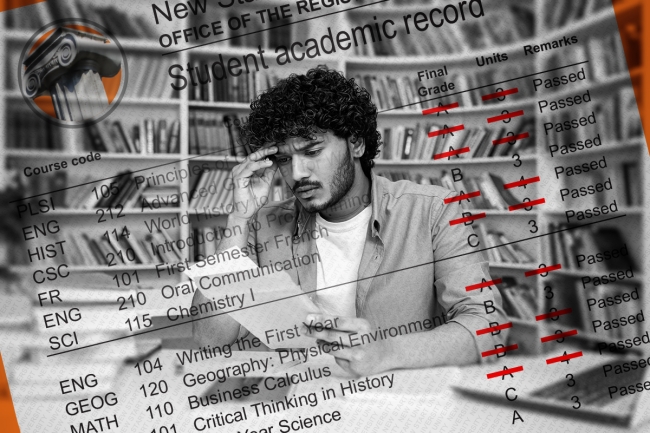You have /5 articles left.
Sign up for a free account or log in.

Students often lose credits, which they’ve already spent money on, in the process of transferring from one college to another.
Photo illustration by Justin Morrison/Inside Higher Ed | Getty Images
Attending a two-year college is often viewed as a more affordable path to a bachelor’s degree, especially for first-generation students or those from low-income backgrounds. Although practical in theory, in practice most students don’t follow that path.
A new report released Tuesday by the Center for Community College Student Engagement (CCCSE), a research initiative at the University of Texas at Austin, said that while 83 percent of students attending a community college for the first time say they intend to transfer to a four-year institution, significantly fewer actually do so. The report cites National Student Clearinghouse Research Center data showing that just 32 percent of community college students transfer to four-year institutions.
The report’s findings reflect the experiences of 8,836 students surveyed at 40 different community colleges in fall 2022 and indicate that students encountered difficulties in the transfer process that hindered them from transferring or made it more onerous and frustrating.
Despite a growing range of transfer support services being implemented at community colleges across the country, the report illustrates that few students feel they get the guidance they need to succeed.
Almost half (47 percent) of community college students surveyed were unaware of the transfer assistance services available at their college, according to the report. And even among the students who did know about transfer assistance, only 24 percent said they utilized the service.
Linda García, executive director of CCCSE, said this pattern isn’t entirely new, but the study’s data “magnifies situations and challenges that students may face” that are barriers to the transfer process. She is calling on college administrators to take a deeper look at potential solutions and said higher ed officials should start by providing students a greater amount of guidance, doing so earlier in a student’s academic journey and making it “inescapable.”
“Think about the student that’s entering in the fall semester. They’re inundated with so much information,” she said. “So how do we connect the students with the information at all times?”
“Having those conversations early on is key,” García added.
Elizabeth Cox Brand, executive director of the Oregon Student Success Center, said it was “disheartening” to learn that students were still having problems transferring despite the expansion of transfer assistance efforts. She said the “million-dollar question” is why students aren’t utilizing the resources that are available. She believes community college leaders should start asking that question of students.
The survey also found that although Pell Grant recipients intend to transfer at the same rates as non-Pell recipients, they are much less likely to actually transfer than their higher-income peers, 25 percent and 41 percent, respectively.
John Fink, a senior research associate at the Community College Research Center at Columbia University’s Teachers College, said the process of transferring is generally an uphill battle.
“Sometimes I think about it like a DIY transfer pathway,” Fink said. “They’re really sort of on their own to figure this out.”
But even community college advising doesn’t always guarantee a smooth transfer.
A student who participated in one of many focus groups conducted by CCCSE over the past several years— the focus groups were not part of the most recent study but were cited in the report—said she clearly told her academic adviser which four-year college she wanted to attend and what subject she wanted to study when they met to plan her schedule for completing the associate degree program.
“We sat there and signed up for the classes together,” the student said. But then, “A week later, I went to the [four-year] college … They told me that the list was not accurate, and so I had to change my classes.”
Miscommunications such as these are often a result of the vast variability and frequent changes in institutional transfer requirements, Fink said.
“If you have 10 different university destinations, and students going into just, say, 10 or 15 majors across those … That’s 150 different combinations,” he explained. “Then you layer on six, seven, 800 students on a caseload. We’re just creating an impossible situation for advisers.”
Students that have the most transfer success are often those who know where they want to study and who speak directly to that college’s advisers.
“These are the students that have kind of figured it out. They’re like, ‘We need to go right to the source to get this advice from the universities,’ and they shouldn’t have to do that,” Fink said. It also requires a pre-existing awareness of how the university system works, “So that’s not quite fair, to have that sort of hidden knowledge about the transfer process,” he added.
Contacting four-year institutions directly is also students’ least likely method of seeking counsel, according to the CCCSE report. Just 14 percent sought information directly from four-year colleges they were interested in attending, compared to those who relied on friends and family or community college instructors for information (29 percent each) or college staff (28 percent), the report said.
Both Fink and García said while it is the responsibility of community colleges to continue improving their advising programs, it’s also important for four-year institutions—which receive larger sums of state and federal funding and have greater access to resources—to help make the process easier for students.
“Transfer is a partnership between a community college and university, and so the solution needs to be a collective effort,” Fink said.
Solutions at Work
The Transfer Scholar Network is one example of such a partnership. TSN assists community college students in overcoming barriers to applying to highly selective colleges and also helps the institutions themselves establish a stronger student pipeline for increasing diversity.
“Many of these four-year institutions are really starting to wholeheartedly look at those barriers that really stand in the way,” said Adam Rabinowitz, the senior communications manager for the Aspen Institute College Excellence Program, who is helping to lead the TSN project. “It’s not just about the dedicated outreach and support. It’s also about concrete practice.”
Although there is not a direct advantage to applying as a TSN student, after being nominated by community college faculty and staff, each participant is connected with a dedicated admissions representative to help answer any questions about the application process. Students can also utilize webinars on financial aid, credit transfer and the student experience.
Of the students who’ve applied to at least one of the selective institutions so far, about 20 percent were accepted. That’s five percentage points higher than the average acceptance rate for general applicants at the same institutions.
“The idea is, if the network can act as a platform for students to learn more, that we will be able to support those students … who would normally be very qualified for our institutions but wouldn’t know about it,” said Adam Sapp, assistant vice president of admissions at Pomona College, a selective TSN partner.
Other successful partnerships include ADVANCE and DirectConnect at the University of Central Florida. Both are dual-admissions partnerships, which allow students to earn associate degrees at a community college and then seamlessly transition to a four-year college with no additional application required. ADVANCE is offered at Northern Virginia Community College and George Mason University, and Direct Connect is offered at UCF and several Florida two-year institutions.
Cox Brand, of the Oregon Student Success Center, views the study’s results as overlapping with the core pillars of guided pathways, which are designed to help students explore, choose, plan and complete programs aligned with their goals.
But the CCCSE survey found that over half of students who said they intended to transfer lacked a clear vision of where they wanted to study, what they wanted to major in or both. “In guided pathways, that’s one of the first tenets—let’s help students figure out what they want to do … and get them connected with people who have the information,” Cox Brand said. “If we don’t get the students on the right path early, then they’re much less likely to be successful as they get down the road.”








